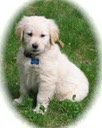Your new Golden Retriever puppy will be exciting and your child will want to spend a lot of time holding and playing with the pup after you bring it home. You must remember that your puppy, though cute and tiny, is still an animal. Animals have instincts that differ from humans.
You must keep in mind that your puppy will usually only tolerate so much from a small child. Explaining to your son or daugther how to play with the new pup is important. Tips include: explaining that all living creatures feel pain and to be very gentle when playing with the pup, not to bother the pup too much especially while he is eating or sleeping, and that screaming, pulling, kicking, and restraining your pup is very harmful and should never be allowed.
You must always have an adult supervising the interaction of your child with your puppy. Show your child by example what is considered nice and good play, so your child has something to follow. Have your child help with walking and feeding the new puppy; this will teach your child responsibility and respect for animals. Allowing your child to help with bathing the puppy will also show your child about responsibilities. Once your son or daughter understands these ideas, you can slowly allow for more alone play time but supervision is always best.
Once your child understands the concepts, having your child attend training classes with your puppy is a smart idea (AFTER they have all their shots!) This step will show your child tips to training. Your child can watch on and see how the trainer interacts with the Golden Retriever puppy and follow by example.
Sometimes a child can be afraid of dogs, even a Golden Retriever puppy. This is very common and can be resolved over time to allow your child to live a life filled with the joy of having animals around. Some tips to cure this phobia or fear include:
• Teach your child to remain calm around the new puppy. Most children will scream and run away when they are frightened, this will only startle the dog and cause the dog to react in a playful or scared manner. When you remain calm, the dog has no reason to behave otherwise.
• Tell your child your puppy's name. Most dogs have a cute or non threatening name that sounds much better than just calling the dog a dog; this will help your child feel more at ease, and may be more inclined to approach the puppy.
• You can now take your child to a park and have her watch the dogs in their element of play and fun. Show her the ones that are behaving nicely; this will allow for a comfort level around the dogs. She will be used to seeing many different types of dogs, including your puppy, playing in a non-threatening way.
©
